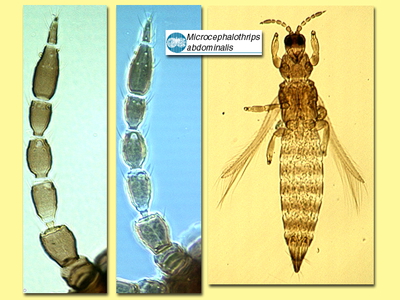Figures
Fig. 1 Antenna, head, thorax and abdomen
Fig. 2 Pronotum
Fig. 3 Fore and hind wing
Fig. 4 Head (dorsal)
Fig. 5 Meso- and metanotum
Fig. 6 Sternites VI and VII
Fig. 7 Tergite VIII
Species
Microcephalothrips abdominalis Crawford
Biology
Breeding commonly in the flowers of sunflowers, Helianthus annuus.
Distribution
Widespread in the tropics and subtropics.
Recognition
Small brown thrips with forewing almost uniformly shaded. Antennae 7-segmented, sense cone on III & IV small but forked. Head relatively small, no setae in front of fore ocellus, one pair lateral to ocellar triangle. Pronotum trapezoidal and wider at posterior; 2 pairs of short posteroangular setae, posterior margin with 5 pairs of minor setae; prosternal basantra with 5 or more pairs of setae. Metanotum with irregular lines of sculpture that form a lens-like arrangement on posterior third; median setae not at anterior margin. Forewing first vein with 3 setae on distal half. Tergite II with 3 lateral marginal setae; II-VIII with posterior margin bearing a craspedum of triangular teeth, on VIII these teeth bear long slender microtrichia; tergites V-VIII with ctenidia laterally, on VIII these are posteromesad to the spiracle. Sternites with two irregular rows of discal setae.
Related species
This is the only species in this genus. In structure it is essentially an unusual member of the genus Thrips, with the pronotum trapezoidal and bearing 5 pairs of posteromarginal setae.








